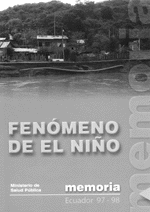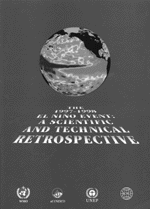|
The
El Niño (ENSO) Phenomenon, a Proposal from Ecuador
 The
first intergovern-mental meeting on the 1997-1998 El Niño phenomenon
was held in Guayaquil, Ecuador, 9-13 November 1998. On the basis of the
Inter-Agency Task Force created in response to Resolution 52/200 in 1997,
coordinated by the IDNDR Secretariat, this exchange of local, national
and international experiences in the scientific and socioeconomic fields
encouraged the World Meteorological Organization (WMO) and its partner
organizations to prepare a Retrospective on El Niño 1997-98. At
the same time, the government of Ecuador offered to carry out a feasibility
study on the possibility of establishing a regional or international centre
for the study of the El Niño Phenomenon in Guayaquil. The
first intergovern-mental meeting on the 1997-1998 El Niño phenomenon
was held in Guayaquil, Ecuador, 9-13 November 1998. On the basis of the
Inter-Agency Task Force created in response to Resolution 52/200 in 1997,
coordinated by the IDNDR Secretariat, this exchange of local, national
and international experiences in the scientific and socioeconomic fields
encouraged the World Meteorological Organization (WMO) and its partner
organizations to prepare a Retrospective on El Niño 1997-98. At
the same time, the government of Ecuador offered to carry out a feasibility
study on the possibility of establishing a regional or international centre
for the study of the El Niño Phenomenon in Guayaquil.
The 1997-1998 experience,
presented during the Guayaquil meeting, the IDNDR Hemispheric Meeting
and other forums, highlighted once more the devastating effect of the
extreme climatic conditions associated with ENSO on the economic development
of Third World nations. A study by Munich Reinsurance estimated the economic
losses of the four countries most affected at anywhere from 1.7% of GNP
in El Salvador to 11% in Ecuador. Participants agreed on the need to reinforce
climate monitoring, improve forecasting and early warning systems, build
capacity and improve access to information tailored to specific sectors.
 Attendees
also learned about a feasilibity study for the creation of an El Niño
Centre in Guayaquil. The study was carried out by a WMO technical mission
and presented to the UN General Assembly in November 1999; a resolution
was adopted urging the UN Secretary General to provide the necessary support
for its implementation. The government of Ecuador expressed its willingness
to provide the main funding for staff and maintenance costs. Attendees
also learned about a feasilibity study for the creation of an El Niño
Centre in Guayaquil. The study was carried out by a WMO technical mission
and presented to the UN General Assembly in November 1999; a resolution
was adopted urging the UN Secretary General to provide the necessary support
for its implementation. The government of Ecuador expressed its willingness
to provide the main funding for staff and maintenance costs.
The study claimed,
It is urgent to establish
a centre to study the ENSO phenomenon and the application of forecasting
techniques primarily for the Latin American region, which would work in
close coordination with global centres and other regional centres.
Some of the information
products of the Centre would be the following:
- Research findings
using appropriate techniques that have been adapted to the region.
- Research on the
sensitivity of the various socioeconomic sectors to climate changes.
- The permanent
updating of assessments concerning the occurrence of climatic extremes
to guide the design of infrastructure, the cost of insuring it, etc.
- Regional projections
on the state of ENSO and its implications within a three-to-six month
period.
- Advise and monthly
alerts aimed at general users.
- Advise and monthly
alerts aimed at specific sectors.
The study reco-mmended
that the Centre establish formal institutional arrangements with national
me-teorological and hydrological orga-nizations and coordinate its efforts
with those of IDNDR-ISDR (CRID), UNDP, PAHO/WHO, WMO and others that supply
infor-mation and tech-nical advise on risk prevention, preparedness and
reduction.
For more information,
please contact:
Ministry of Foreign Relations, Ecuador,
Fabián Paliz
Tel (593-2) 455-191
|

